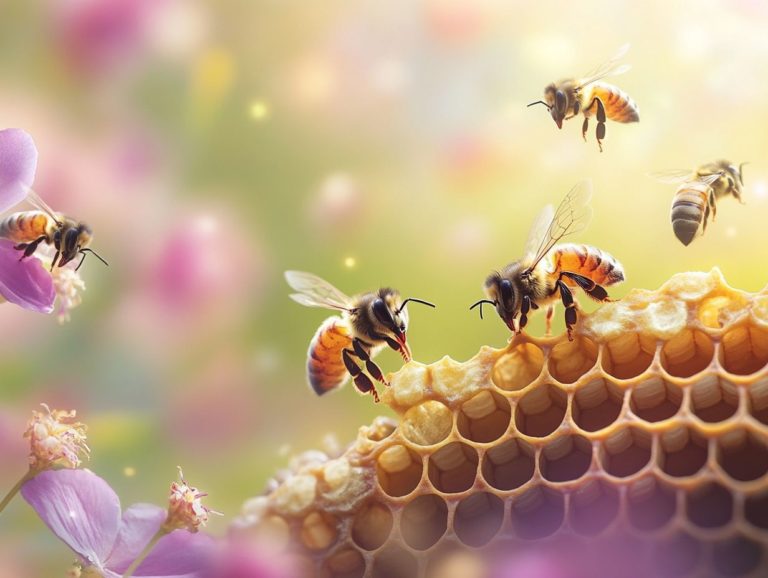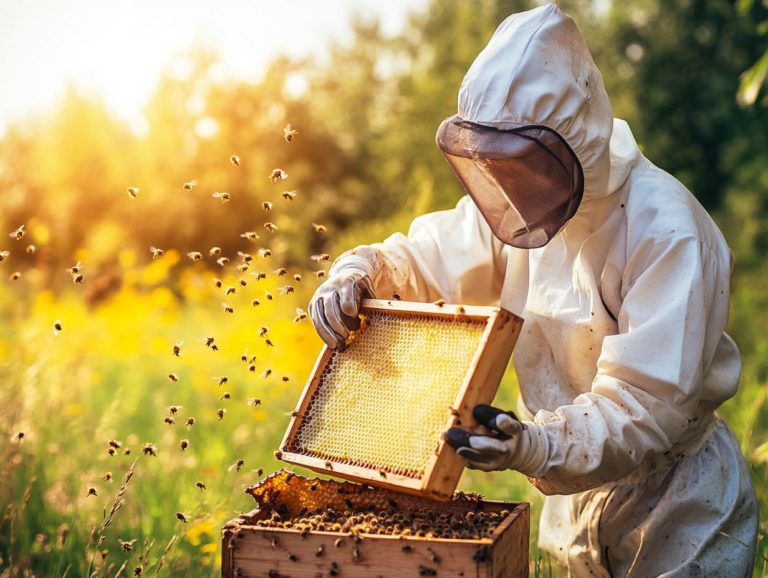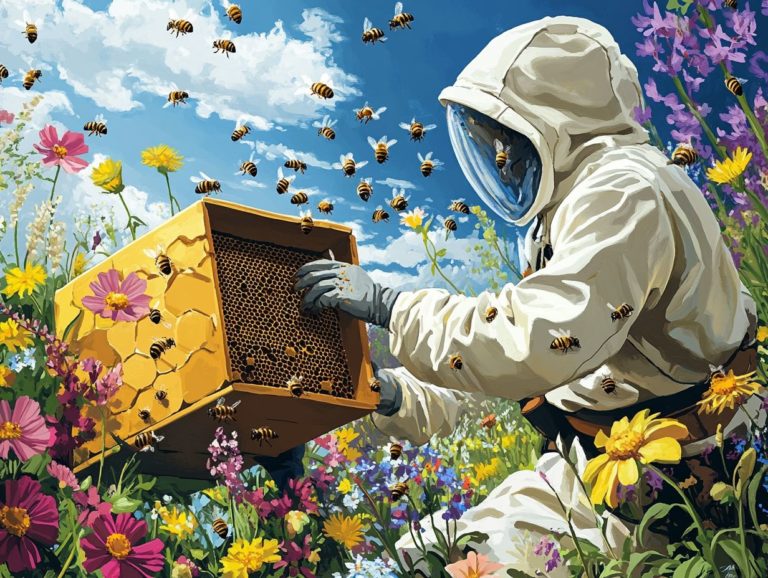Understanding the Lifecycle of Bees in Hives
Honey bees are truly fascinating creatures, playing an essential role in our ecosystems and agricultural systems alike. Let’s explore the intricate lifecycle of bees within their beehives, shedding light on the distinct roles of the queen bee, worker bees, and drone bees. You’ll uncover the remarkable processes behind honey production, as well as the significance of propolis and beeswax, all while understanding how seasonal changes influence hive dynamics.
This piece also highlights the threats bees face today, particularly focusing on the life cycle of honey bees. Discover the wonders of bee life and the challenges they face, and understand the critical importance of protecting these remarkable beings.
Contents
- Key Takeaways:
- Understanding the Lifecycle of Bees
- The Life of Bees in the Hive
- The Seasonal Changes in the Hive
- Threats to the Bee Lifecycle
- Frequently Asked Questions
- What is the lifecycle of bees in hives?
- What are the stages of the lifecycle of bees in hives?
- How long does it take for bees to go through their lifecycle in hives?
- What is the role of worker bees in the lifecycle of bees in hives?
- How does the queen bee factor into the lifecycle of bees in hives?
- What happens to bees at the end of their lifecycle in hives?
Key Takeaways:

- The queen bee is the most important member of the hive, responsible for laying many eggs every day and maintaining the hive’s population.
- Worker bees are vital. They collect nectar, make honey, and care for the queen and her brood.
- The lifecycle of bees is heavily influenced by seasonal changes and the availability of food sources.
Understanding the Lifecycle of Bees
The lifecycle of bees presents a captivating and intricate process that involves a variety of roles, including the queen bee, worker bees, and drone bees. Each plays a vital part in the overall health and productivity of the bee colony.
This dynamic system kicks off with the queen bee laying eggs in honeycomb cells, which develop into bee larvae that move through distinct stages: larva stage, pupa stage, and finally, adulthood. Each of these stages is crucial for maintaining the colony’s social structure and ensuring its survival, revealing the intricate relationships and hive dynamics among the different bee species. For a deeper understanding, consider exploring the life cycle of a bee.
Meet the Queen Bee
The queen bee stands as a key member within a beehive, entrusted with the essential task of egg-laying and safeguarding the hive’s population through her reproductive role. Her responsibilities extend beyond simple egg production; she carefully lays many eggs every day, placing them into specialized cells known as queen cells.
Each egg holds the potential to develop into a new bee, but the larvae destined to become future queens receive a unique diet of royal jelly a special food for future queens that fosters their growth and enhances their reproductive capabilities.
The mating process is equally significant. Once she emerges from her cell, a virgin queen embarks on mating flights, where she meets male bees for mating. This momentous occasion not only fertilizes her eggs but also ensures genetic diversity within the hive, a crucial factor for the health and resilience of the bee colony, aided by bee pheromones.
The Hardworking Worker Bees
Worker bees are the backbone of the beehive, tirelessly performing essential tasks that ensure the colony’s survival. You’ll find these industrious creatures foraging for food, maintaining the hive, and caring for the queen and her brood.
These dedicated insects venture out on missions to collect nectar and pollen, which provide crucial nutrients for the entire colony. But their work doesn’t stop there; they also engage in hive maintenance, meticulously ensuring the honeycomb remains clean, organized, and free from pests each detail directly affecting the hive’s overall health.
With their remarkable ability to communicate through intricate dances, they share vital information about food sources and potential threats. This effective communication fosters collaboration, allowing the colony to thrive. By balancing these roles, worker bees not only support the queen and developing larvae but also bolster the hive s resilience, enabling it to withstand various environmental challenges. This form of bee communication is essential for maintaining hive functions.
The Drone Bees
Drone bees hold a vital place in the reproductive dynamics of the hive. They are the male honey bees whose primary role is to mate with the queen bee during her mating flights.
Unlike worker bees, drones do not possess stingers or engage in specialized tasks. Their lifespan generally spans a few months and largely hinges on their reproductive endeavors. This lifespan is directly tied to their success in mating flights.
When the queen embarks on her nuptial flights, these drones engage in fierce competition to secure a mating opportunity, typically mid-air. This exciting event boosts the genetic diversity of the colony, which fosters healthier offspring and enhances the overall resilience of the hive.
Once a drone successfully mates, its life concludes, underscoring the singular purpose that defines its existence within the intricate social structure of the hive. The drone’s role in the reproduction cycle is thus fulfilled.
The Life of Bees in the Hive
The life of bees within the hive presents a remarkably intricate connected system. Here, various bee species work together seamlessly, each playing a crucial role in optimizing honey production, maintaining the hive, and ensuring the overall health of the colony.
The Process of Making Honey
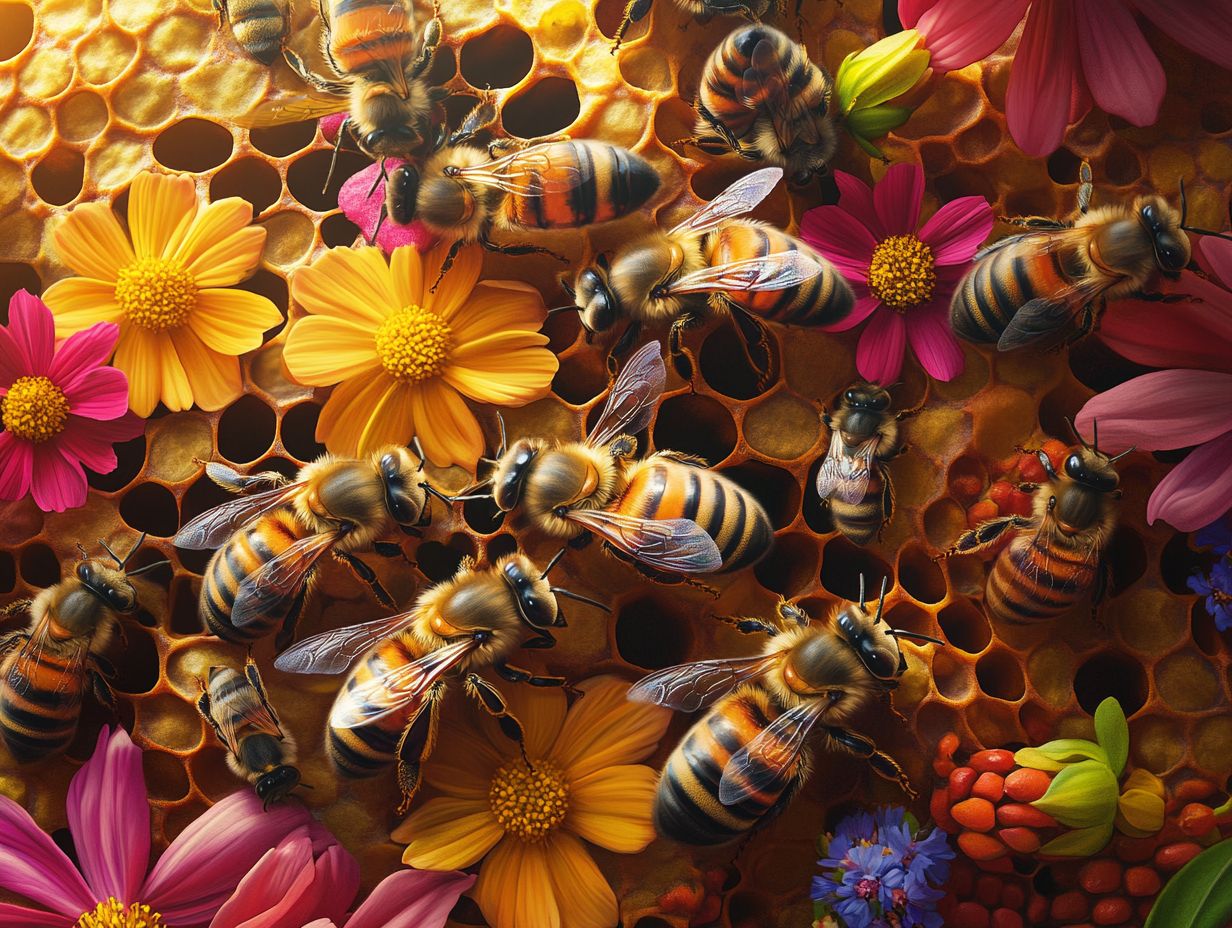
The art of honey-making is a remarkable journey. Worker bees diligently collect nectar and pollen from flowers, transforming these natural gifts into honey through a captivating series of steps within their hive.
First, envision these industrious bees flitting from bloom to bloom. They use their long tongues to suck up the sweet nectar. They store this nectar in their specialized stomachs, aptly named the ‘honey stomach’, where the transformation begins.
As they gather nectar, they also collect pollen, which provides essential nutrients for their colony. Upon returning to the hive, the bees regurgitate the nectar into the mouths of their hive mates.
Here, enzymes come into play. These are substances that help break down sugars. This process is crucial because it changes the nectar into honey, making it easier to store and ensuring it can be preserved for long periods by capping the honey with wax.
The bees then deposit this thickened substance into hexagonal wax cells, allowing it to undergo further dehydration. The result? The delicious and enduring honey that we all cherish.
The Role of Propolis in the Hive
Propolis, often called ‘bee glue,’ plays a crucial role in maintaining the health and stability of the hive. It acts as a natural antimicrobial substance and significantly contributes to colony health.
This remarkable resinous mixture, collected from tree buds and sap, is used by bees to seal cracks, insulate their home, and create a sterile environment essential for the colony’s survival.
Propolis also acts as an effective barrier against pathogens and pests, significantly lowering the risk of infections that could threaten the hive’s very existence. Different species of bees, like honeybees and bumblebees, exhibit unique ways of using propolis, highlighting its versatility.
For example, honeybees coat their hive s interior surfaces extensively with it, while bumblebees tend to apply it more sparingly. CarolinaHoneyBees.com and BuzzAboutBees.net provide additional insights into the various applications of propolis.
Through these practices, propolis not only boosts the overall health of the colony but also fosters a harmonious living space, protecting the delicate balance of the apiary ecosystem.
The Importance of Beeswax in the Hive
Beeswax is vital for the construction and upkeep of a hive, allowing bees to craft honey storage cells for the secure storage of honey and bee brood.
This remarkable substance is produced by worker bees through a fascinating process involving specialized glands that secrete the wax in delicate scales. Once these scales are secreted, it takes about a week for the wax to meld into the honeycomb structure. This structure is essential not only for storing honey and pollen but also for nurturing developing larvae, underscoring the significant role of beeswax in hive dynamics and bee development.
The intricate design of the hexagonal honeycomb maximizes space while ensuring durability, allowing the colony to maintain optimal conditions within the hive. Beeswax also seals cracks in the hive and helps regulate temperature, making it a critical resource for the survival and health of the colony.
The Seasonal Changes in the Hive
The seasonal changes within the hive profoundly impact the lifecycle of bees, shaping their behavior, activities, and the overall dynamics of the hive as the year unfolds. These changes are evident in the diverse hive roles and the adaptive strategies employed by different bee species.
Spring: The Start of the Bee Lifecycle
Spring heralds the awakening of the bee lifecycle, as the queen bee resumes her egg-laying duties and worker bees shake off their winter slumber to embark on their foraging quests!
With rising temperatures and an explosion of blossoms, you’ll notice the hive buzzing with renewed energy and activity. The queen takes the spotlight, diligently laying thousands of eggs to secure the colony’s future. Meanwhile, worker bees, inspired by the vibrant nectar-rich flowers that emerge, spread out into the surroundings. They gather nectar and pollen, essential resources that not only nourish the growing larvae but also play a crucial role in honey production.
This lively season is pivotal for the health of the hive. The synchronized efforts of the queen and her loyal workers redefine the colony’s structure and uphold their collective purpose.
Summer: The Peak of Hive Activity
Summer bursts into life as the hive reaches its peak activity!
During this dynamic season, the bees are particularly industrious, venturing out to gather nectar and pollen from a rich variety of blooming flowers. This not only nourishes them but also replenishes the hive’s honey reserves, creating a flourishing environment for the colony to expand and grow stronger.
As a beekeeper, you can observe worker bees diligently communicating the locations of the best foraging spots with their intricate waggle dance, a special dance bees do to communicate the locations of flowers. This collective endeavor is vital for the colony’s overall well-being, fostering resilience and productivity, making summer an exhilarating period for both the bees and you as their keeper.
Fall: Preparing for Winter
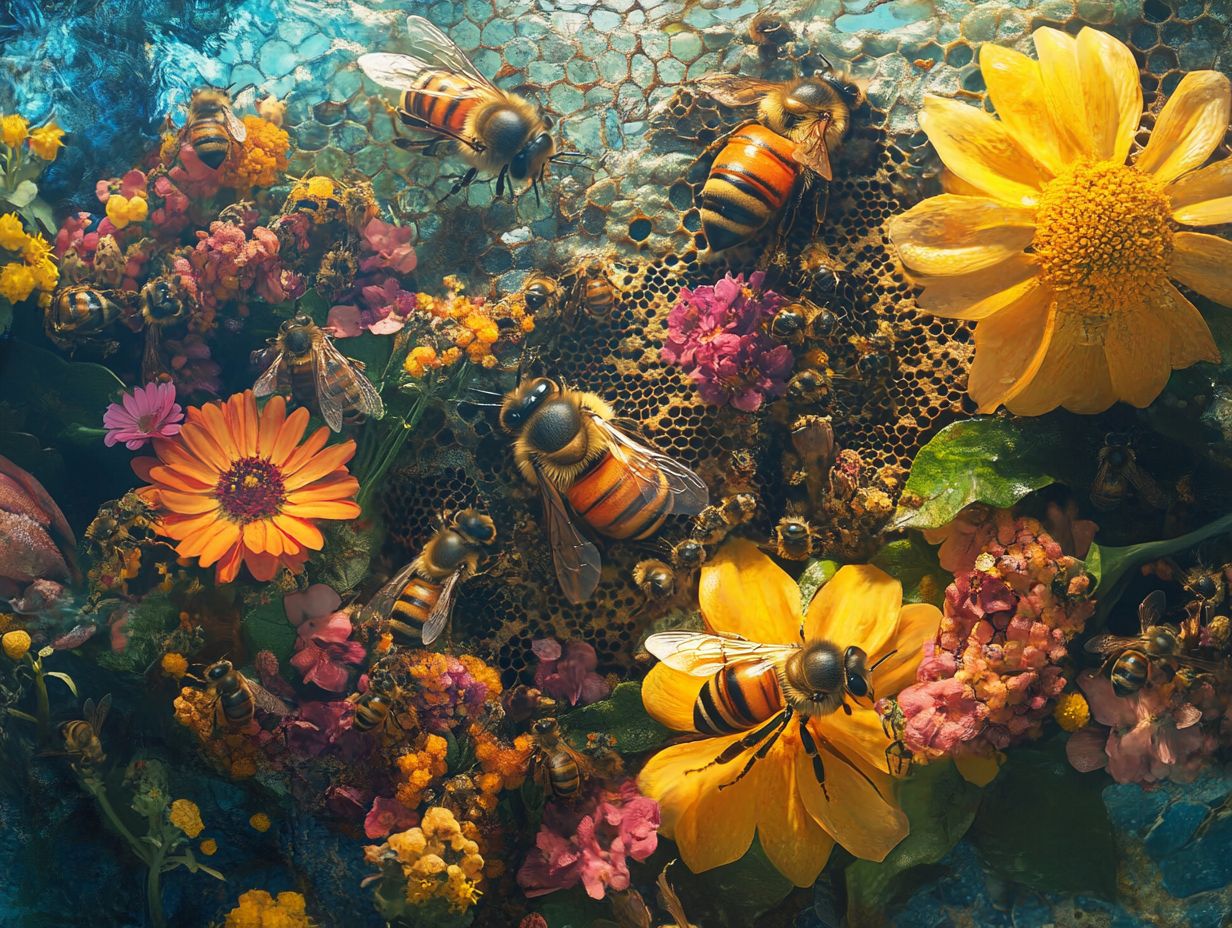
As fall approaches, you ll notice bees shifting their focus toward preparing for winter, ensuring their colony has enough resources to survive the colder months ahead.
During this transitional period, they employ several key strategies to enhance their chances of enduring the harsh winter:
- Foraging for late-blooming flowers and autumn pollen sources, which are essential for stockpiling honey. This honey becomes the main food source as temperatures drop.
- Bees cluster together within the hive to generate heat, maintaining a stable internal temperature that is vital for the queen and the brood. This behavior not only conserves energy but also protects them from the frigid external environment, ensuring the colony remains resilient through the winter lull.
Winter: Survival in the Hive
Winter poses considerable challenges for bees, compelling them to rely on their stored honey and adapt their behaviors to endure the harsh conditions.
During this season, the social dynamics within the hive become paramount to their survival. As temperatures plummet, bees cluster together in a tight ball, generating heat through their collective warmth. This social structure not only helps maintain a stable temperature but also provides essential protection for the queen and the brood.
The stored honey transforms into a vital food source, as foraging becomes impossible in the frigid landscape.
Bees exhibit remarkable adaptations, such as slowing their metabolism and entering a semi-dormant state, which allows them to conserve energy while patiently awaiting the return of warmer days.
Threats to the Bee Lifecycle
Threats to the bee lifecycle have escalated into a pressing concern, as factors like pesticides, habitat loss, and diseases increasingly jeopardize the health and survival of bee populations across the globe.
Pesticides and Other Chemicals
Pesticides and other chemicals present serious risks to bee health, affecting their behavior, reproduction, and the overall vitality of their colonies.
Numerous studies have delivered compelling evidence illustrating how these chemical threats jeopardize the integrity of bee populations, highlighting their crucial role in the decline of essential insect pollinators. For instance, research has demonstrated that neonicotinoids a commonly used class of pesticides disrupt foraging patterns and impair cognitive functions, making it increasingly difficult for bees to navigate and find their way back to their hives.
Exposure to these toxic substances correlates with decreased reproductive success and heightened vulnerability to diseases, ultimately leading to a reduction in colony numbers.
As you delve deeper into the intricate relationship between bees and pesticides, understanding these detrimental effects becomes paramount for championing effective policies that protect these critical pollinators.
Loss of Habitat and Food Sources
The loss of habitat and food sources presents a critical challenge for many bee species, resulting in diminished foraging opportunities and, ultimately, the decline of their colonies.
Several factors contribute to this concerning trend, with urbanization and agricultural practices playing significant roles. As cities expand, natural landscapes are often replaced by concrete structures and roads, erasing vital foraging areas that bees rely on. Meanwhile, modern farming techniques frequently favor monoculture, where a single crop species dominates the landscape. This approach reduces the variety of flowers available for bees to forage, severely limiting their nutritional options. Bees depend on a diverse array of plants to thrive, and this reduction in floral diversity poses a serious threat to their health.
To bolster bee populations, it is essential for you to advocate for the preservation and restoration of habitats, as well as to promote sustainable agricultural practices that enhance diverse ecosystems. Your efforts can significantly impact the health of bee communities and contribute to a more balanced environment.
Diseases and Parasites
Diseases and parasites pose significant threats to bee health, profoundly impacting colony dynamics and contributing to alarming population declines. Among these threats, the Varroa mite stands out as one of the most notorious. This insidious parasite latches onto bees and feeds on their bodily fluids, leading to weakened immune systems and, in some cases, death.
When infestations occur, you may notice a range of symptoms: diminished bee populations, deformed wings, and a general lethargy among the worker bees. Other common ailments, like Nosema, a fungal infection, can induce dysentery and reduce foraging efficiency, severely hampering a colony’s productivity. Observations from trials involving infected colonies reveal significant behavioral changes, compromising their ability to communicate effectively through dances and ultimately diminishing their foraging success.
Addressing these challenges is essential for maintaining robust bee populations and ensuring the sustainability of the invaluable pollination services they provide.
Frequently Asked Questions
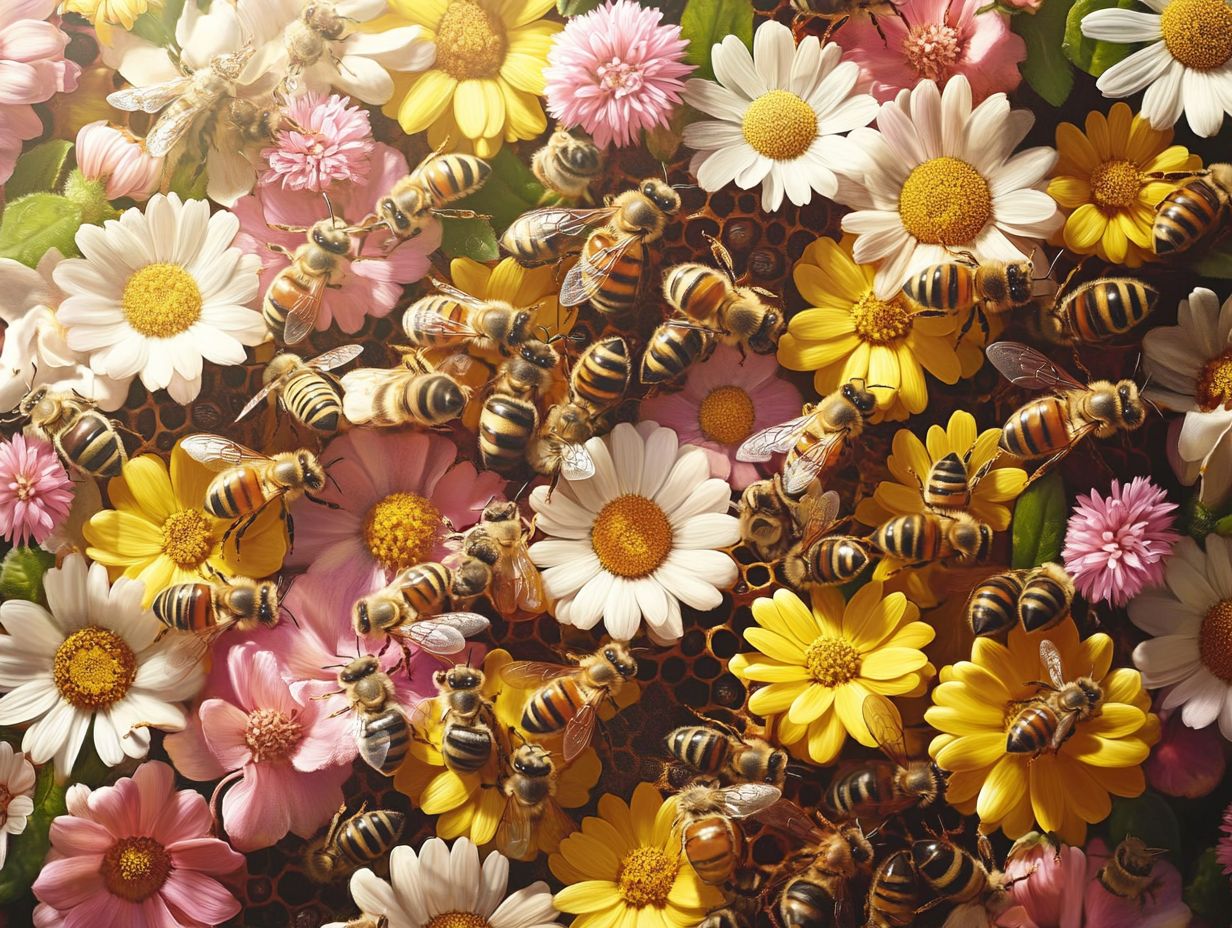
What is the lifecycle of bees in hives?
The lifecycle of bees in hives includes the different stages that honeybees undergo, from egg to adult, all within the hive.
What are the stages of the lifecycle of bees in hives?
The stages include egg, larva, pupa, and adult. Each stage serves a vital role in maintaining the hive’s health.
How long does it take for bees to go through their lifecycle in hives?
The entire lifecycle takes about 21 days. However, variations can occur based on bee type and environmental conditions.
What is the role of worker bees in the lifecycle of bees in hives?
Worker bees form the majority of the hive. They care for the eggs, larvae, and pupae, build the hive, gather food, and protect it from dangers.
How does the queen bee factor into the lifecycle of bees in hives?
The queen bee is vital! She lays eggs that determine the colony’s size and produces pheromones that guide the other bees’ behavior.
What happens to bees at the end of their lifecycle in hives?
At life’s end, worker bees often die while foraging. The queen may die or leave to form a new colony, and new queens will emerge to continue the cycle.

